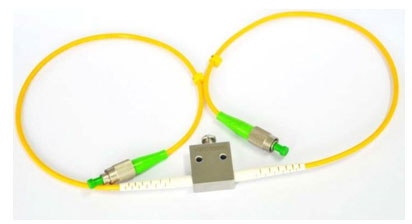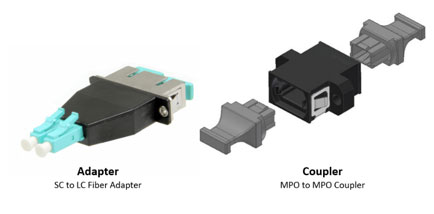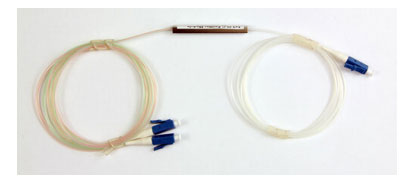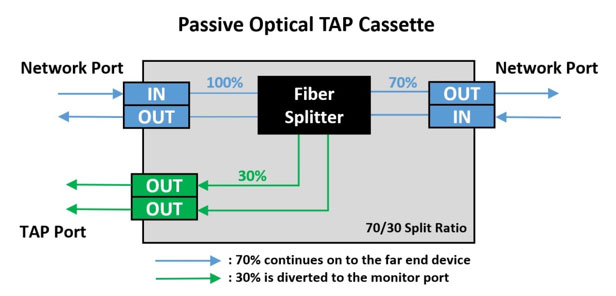When it comes to fiber optic connectivity, we always hear a lot about the various types of connectors and their applications such as duplex LC connectors and multi-fiber MTP/MPO connectors. As probably the most critical infrastructure component in a fiber link along with the cable itself, it’s no wonder that connectors get the most attention.
But there are plenty of other connectivity components that can also be a part of the underlying fiber infrastructure, including attenuators, adapters, couplers, and splitters. Each of these components has a different use for a variety of applications and scenarios.
Attenuators
Most of the time, we think of attenuation (i.e., insertion loss) as a bad thing in a fiber network with the need to limit loss as much as possible. But sometimes there is the need to actually suppress signal strength to ensure that the signal matches the requirements of the active equipment. If the incoming signal is too strong for the receiver, it can saturate the detector and prevent proper transmission or cause damage to the receiver elements. This can occur for example when using a media converter that is designed for a much longer distance. Attenuators can be inserted into a network to reduce signal power without distortion before it is delivered to the receiver. Attenuators are also used to calibrate signal loss when testing the dynamic power level range or in specialty photo sensor or photo detector applications that require reduced signal strength.
 There are two primary types of attenuators—variable and fixed. Variable optical attenuators (VOAs) allow for manually adjusting the attenuation of the signal, which is ideal when there is a need to precisely balance signals strength. This is typically achieved by adjusting a screw that changes the internal blocking mechanism to increase or decrease signal loss. In contrast, fixed optical attenuators are available with a specific attenuation amount, such as 1 dB, 2 dB, 3 dB, and so on. Fixed attenuators are also often plug-in style for use at the equipment, and it’s important to select an attenuator with the connector type that matches the equipment or device requiring the reduced signal.
There are two primary types of attenuators—variable and fixed. Variable optical attenuators (VOAs) allow for manually adjusting the attenuation of the signal, which is ideal when there is a need to precisely balance signals strength. This is typically achieved by adjusting a screw that changes the internal blocking mechanism to increase or decrease signal loss. In contrast, fixed optical attenuators are available with a specific attenuation amount, such as 1 dB, 2 dB, 3 dB, and so on. Fixed attenuators are also often plug-in style for use at the equipment, and it’s important to select an attenuator with the connector type that matches the equipment or device requiring the reduced signal.
Adapters and Couplers
 Fiber optic adapters and couplers are designed to mate two terminated fibers cables together in a way that precisely aligns the fiber end faces for minimal loss. The two terms are often used interchangeably, but just like in the plumbing world; an adapter is technically used to join two dissimilar components while a coupler is used to join two of the same components together. For example, a fiber optic adapter can be used for connecting cable terminated with an ST fiber connector to one that is terminated with an LC fiber connector. Fiber optic couplers on the other hand join two fibers together that are terminated with the same connector type—whether that’s an LC or an MTP/MPO.
Fiber optic adapters and couplers are designed to mate two terminated fibers cables together in a way that precisely aligns the fiber end faces for minimal loss. The two terms are often used interchangeably, but just like in the plumbing world; an adapter is technically used to join two dissimilar components while a coupler is used to join two of the same components together. For example, a fiber optic adapter can be used for connecting cable terminated with an ST fiber connector to one that is terminated with an LC fiber connector. Fiber optic couplers on the other hand join two fibers together that are terminated with the same connector type—whether that’s an LC or an MTP/MPO.
Adapters and couplers can be ganged to accommodate multiple connections and are often panel mounted as part of a fiber patching solution, but they don’t have to be. Adapters are also ideal for joining to dissimilar patch cables together to match equipment I/O requirements, while couplers are ideal for extending the distance of terminated fiber cables. Using a coupler to extend distance can prevent wasting cable or having to re-order in situations where cable lengths are too short because there is not enough fiber left on a spool or due to miscalculations, design changes, or disaster recovery requirements.
Splitters
 Another component that is critical in passive optical network (PON) deployments (i.e., GPON, FTTX, etc.) is the splitter. Sometimes referred to as a beam splitter, optical splitters work by splitting the light signal from a single fiber cable into multiple light beams to distribute service over multiple cables. They are often also used to non-intrusively monitor or test live optical transmission. In fact, passive traffic analysis point (TAP) solutions like the HD8² TAP Cassettes use integrated splitter technology to split a data stream into two paths—one that passes the information on to its original location and the other that transmits copied information to a traffic monitoring port.
Another component that is critical in passive optical network (PON) deployments (i.e., GPON, FTTX, etc.) is the splitter. Sometimes referred to as a beam splitter, optical splitters work by splitting the light signal from a single fiber cable into multiple light beams to distribute service over multiple cables. They are often also used to non-intrusively monitor or test live optical transmission. In fact, passive traffic analysis point (TAP) solutions like the HD8² TAP Cassettes use integrated splitter technology to split a data stream into two paths—one that passes the information on to its original location and the other that transmits copied information to a traffic monitoring port.
While primarily used with singlemode fiber in PON deployments, splitters can also split light signals in multimode systems. They come in two distinct types—planar lightwave circuit (PLC) and fused biconical taper (FBT) splitters. PLC splitters use an optical splitter chip to split signals evenly and support higher split ratios. They can operate across a wider temperature range and work well for WDM applications that use multiple wavelengths for transmission, which is why it is the primary splitter technology used in PON deployments. Ideal for lower split ratios, FBT splitters are typically less expensive because they are made from readily available materials. They also don’t split signals evenly, which allows for customized splits. For example, TAP solutions often use FBT technology to allocate 70% of the signal for the network and 30% for monitoring.

While not as common a traditional fiber connectivity, there are many applications and circumstances that call for attenuators, adapters, couplers, or splitters. The good news is that in addition to traditional fiber connectivity, CablesPlus offers all of these fiber solutions and more to support your unique fiber networking requirements. Click HERE to view our breadth of fiber components or contact us at sales@cablesplususa.com or 866-678-5852 to discuss your needs.

